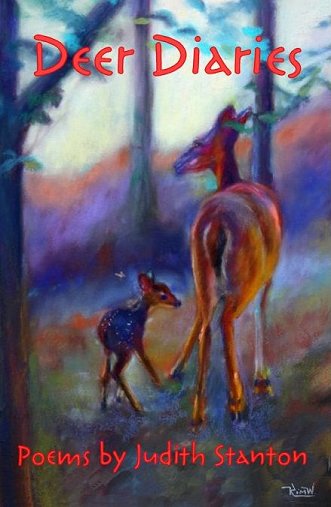…a fresh eye on the mysteries is what’s required.
~ Richard Kenney, “Witness”

Deer Diaries: the Seasons at Cat Crossing Farm chronicles the lives of does and fawns, bucks and birds, turtles and snails, and red-eyed bugs throughout the year. From ice and snow to budding spring to hot, stormy summer days and the blazing colors of fall, Stanton’s luminous poems invite readers to see the wild life in our backyards with new eyes.
If you’ve ever lain awake at midnight, in the morning, and heard deer chomping your shrubbery… if you ever got so lucky as to see a new-born fawn curled up in grass, a ten-point buck clearing the pasture’s gate, an albino doe flashing before you… if you ever stopped in wonder to count the herd at dawn or dusk… you will love Deer Diaries. And not just for the deer, but for a host of other acutely observed rural creatures—birds, a snail, a turtle, and a vibrant brood of cicadas emerging in their thirteen-year cycle.
Another full moon
Tonight the moon’s lace face
clears pinetops, sweet gums, oaks
I tuck barn cats in the tack room
feed horses muck stalls
check water spin into
lunar light purple plum tree
blossoms whispering down
A doe grazes the front lawn
forty yards between us
We lock eyes she fears
an out-of-season hunter
I fear she’ll bolt
How to show her
I’m only here to marvel?
Twin fawns
Two fawns barely old enough
to graze slip inside the fence
from the shelter of the woods
their spots still bright
their mother on patrol.
I look away and sigh
at the disorder of
my kitchen—last night’s
pasta with Italian sausage
onions and green peppers
took a lot of pots. I ought
to clean up my mess now.
But they’re the first twins
I’ve seen this spring, fresh
and delicate, so I look back
only to find them gone.
Any pursuit of wonder
requires obsessive vigilance.
At the first reading of the Deer Dairies, it becomes readily apparent that Judith is a true lover of the outdoor world. She treats Mother Nature’s triumphs and tragedies with equal clarity and compassion. Perhaps this is most obvious in her description of the three-legged doe in the opening poem. What a dire predicament for a deer, yet what a marvelous story how she has survived and now has a new-born fawn.
I think Judith’s philosophy is best expressed in the closing lines of her poem On turning 65 which read “and I remember miracles can happen if I have eyes to see and a heart to remember.”
To me, much “modern” poetry is not poetry, but rather choppy prose, devoid of pace and rhythm. Not so these! Read them aloud, and revel in the marvelous cadence.
~ Al Manning, the resident curmudgeon
